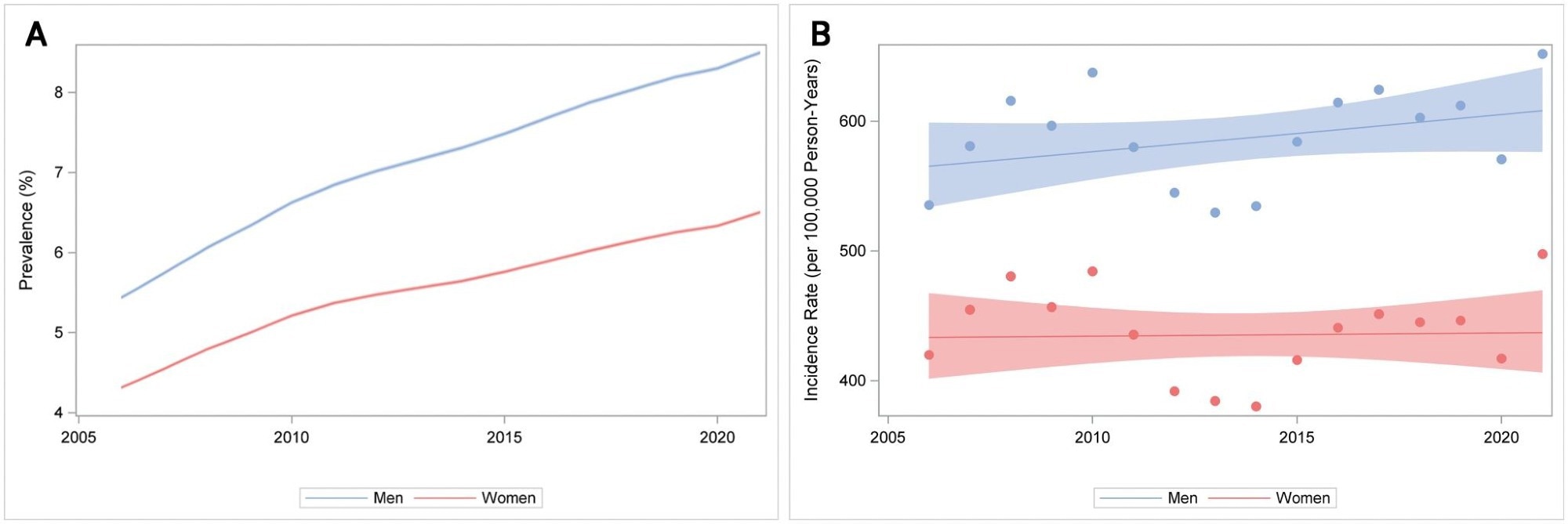Younger Swedes, especially women and ethnic minorities, are being diagnosed with type 2 diabetes at record rates, signaling an urgent need for targeted prevention before the crisis escalates.
 Study: Increasing incidence of early-onset type 2 diabetes in Sweden 2006–2021. Image Credit: PhotoGullak / Shutterstock
Study: Increasing incidence of early-onset type 2 diabetes in Sweden 2006–2021. Image Credit: PhotoGullak / Shutterstock
In a recent article published in the European Journal of Public Health, researchers examined trends in the prevalence and incidence of type 2 diabetes (T2D) in Sweden from 2006 to 2021. Their findings indicate that the prevalence and incidence of T2D, particularly the early-onset form of the disease, have increased over time, especially among individuals with lower educational attainment and those born outside Europe.
The authors note that the absolute incidence of early-onset T2D remains highest in those with primary education; however, the fastest relative rate of increase was observed among people with tertiary education. Importantly, the increase in early-onset T2D was observed across all sociodemographic groups.
Background
The global burden of diabetes has grown in recent decades, largely due to rising prevalence. In many high-income nations, including Sweden, overall incidence rates of T2D have shown signs of stabilizing or declining since 2005. This seeming contradiction, higher prevalence despite flat or falling incidence, could reflect improved life expectancy, leading to a growing number of people living with diabetes. However, the most recent Swedish data only extend to 2013, leaving uncertainty about whether declining trends have persisted.
A more alarming trend is the increasing diagnosis of T2D in young adults and adolescents. The early-onset form is considered more severe, with a higher probability of complications and earlier mortality than late-onset T2D. Globally, its prevalence increased from 2.9% to 3.8% between 2013 and 2021, and its incidence surged by 56% between 1990 and 2019. This rise disproportionately affects disadvantaged groups, such as those with lower socioeconomic status or belonging to ethnic minorities.
Despite reports of rising early-onset diabetes in Denmark and Finland, no national data existed for Sweden. This study filled that gap by analyzing early-onset type 2 diabetes (T2D) trends and projecting future prevalence using national demographic forecasts.
About the Study
The study included everyone born during 1895-1998 and living in Sweden in 2006, as identified from the national Population Register. These individuals were tracked from 2006 to 2021 for diagnoses of T2D. Early-onset T2D was defined as diagnoses occurring between the ages of 23 and 39. The cutoff at age 23 was chosen because individuals born in 1998 (the youngest cohort) turned 23 in 2021, allowing complete follow-up for the entire study period. Diabetes cases were identified using data from three national health registries: the National Patient Register, the National Diabetes Register, and the Prescribed Drug Register.
A combination of diagnostic codes and medication prescriptions was used to define T2D while excluding type 1 and other diabetes types. Sociodemographic information, including birth country and education, was obtained. For individuals diagnosed with T2D, clinical measures such as blood pressure and body mass index (BMI) were obtained from the year of diagnosis.
Incidence and prevalence were calculated for each year and standardized by sex and age. Trends were analyzed using meta-regression, with separate models for different demographic strata.
Researchers also projected the prevalence of early-onset T2D through 2050 by applying current incidence trends to population forecasts, assuming similar survival rates between individuals with and without diabetes. The study could not assess T2D in individuals under 23 or examine trends based on parental immigrant background, and acknowledged some potential misclassification between T2D and gestational diabetes, particularly in young women. The authors used stricter diagnostic criteria in women to minimize this risk.
Key Findings
Researchers followed over 9.1 million individuals in Sweden during 2006-2021. During this period, 529,785 new T2D cases were recorded, including 24,210 early-onset cases. The overall prevalence of T2D rose from 4.87% to 7.5%, and incidence increased slightly from 477 to 574 per 100,000 people. However, this increase in overall incidence was marginal, with the confidence interval including no change. Early-onset T2D showed a more dramatic rise, its prevalence more than doubling (from 0.27% to 0.64%), and incidence nearly doubling (from 54 to 107 per 100,000), with a 4.7% annual increase.
 (A) Age-standardized prevalence (%) of type 2 diabetes in Sweden 2006–2021 by sex. The shaded areas represent 95% confidence intervals. (B) Age-standardized incidence (per 100000 person-years) of type 2 diabetes in Sweden 2006–2021 by sex. The shaded areas represent 95% confidence intervals.
(A) Age-standardized prevalence (%) of type 2 diabetes in Sweden 2006–2021 by sex. The shaded areas represent 95% confidence intervals. (B) Age-standardized incidence (per 100000 person-years) of type 2 diabetes in Sweden 2006–2021 by sex. The shaded areas represent 95% confidence intervals.
The sharpest increases were among people between 23 and 29, especially women. Higher incidence and prevalence were observed in individuals born outside Europe and those with lower educational attainment. Interestingly, incidence rose across all educational levels, with the fastest relative increase among those with tertiary education. People with early-onset T2D were more likely to be obese, smoke, and have poor blood sugar control. Specifically, 71.6% of those with early-onset T2D were obese compared to 50.3% of those diagnosed at older ages, and only 50.3% of early-onset cases had HbA1c within the target range compared to 64.0% for late-onset T2D.
Projections suggest that if current trends continue, the prevalence of early-onset T2D in Sweden could reach 3.2% by 2050. Early-onset T2D now accounts for 16% of new T2D cases, up from 10% in 2006, indicating a significant and growing public health concern. The authors also observed a shift towards younger ages at T2D diagnosis, which implies a longer duration of disease and a greater lifetime risk of complications.
A notable point discussed is that the observed higher incidence in young women may in part reflect earlier detection due to pregnancy-related diabetes screening, and possible misclassification with gestational diabetes, despite measures to minimize this in the study.
Conclusions
The study found a rapid and consistent rise in early-onset T2D across all sociodemographic groups in Sweden between 2006 and 2021. While overall T2D incidence rose modestly, this trend was not statistically robust, and early-onset T2D almost doubled, disproportionately affecting individuals born outside Europe, those with lower education, and young women. This trend is particularly alarming due to early-onset T2D’s association with obesity, poorer glycaemic control, and higher risk of complications. The researchers used robust nationwide data and multiple health registers to ensure accurate case identification.
However, they could not assess T2D in individuals under 23 or those with immigrant parents, and some misclassification of diabetes type may have occurred. Nevertheless, results remained consistent in sensitivity analyses. The study warns that early-onset T2D is becoming increasingly common and will likely burden healthcare systems as it affects individuals in their most productive life stages.
Targeted prevention strategies are urgently needed, particularly for high-risk groups such as ethnic minorities, women of childbearing age, and those with lower educational attainment.
The authors further suggest that the COVID-19 pandemic may have influenced the observed spike in T2D incidence in 2021, but the overall increase in early-onset T2D was a consistent trend over the entire study period.
Journal reference:
- Increasing incidence of early-onset type 2 diabetes in Sweden 2006–2021. Carlsson, S., Andersson, T., Jansson, S., Nyström, T., Raldnsson, O., Wei, Y. European Journal of Public Health (2025). DOI: 10.1093/eurpub/ckaf114 https://academic.oup.com/eurpub/advance-article/doi/10.1093/eurpub/ckaf114/8195859?searchresult=1